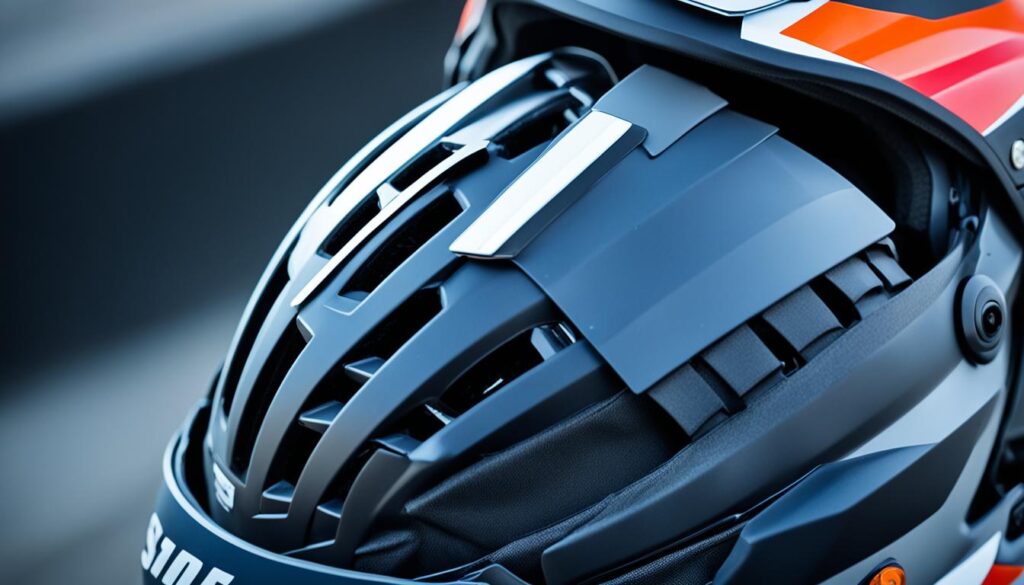
As motorcycle enthusiasts, we all know that wearing a helmet is essential for our safety on the road. But have you ever wondered if you’re strapping your helmet correctly? Are there specific techniques to ensure that your helmet is securely fastened?
In this article, we will explore the step-by-step process of strapping a motorcycle helmet, providing you with the knowledge and confidence to secure your ride. From properly putting on the helmet to tightening the straps, we will guide you through each crucial step.
But before we dive into the techniques, let’s challenge a common belief. Is it really enough to just plop the helmet on your head and hope it stays put? Or is there a science to strapping it in place for optimal safety?
So, if you’re ready to unravel the mysteries of helmet strapping techniques and ensure your motorcycle helmet is securely attached, let’s get started!
- Learn the correct techniques for strapping your helmet
- Understand the importance of a properly fitted helmet
- Discover how to secure the excess strap for a neat and safe ride
- Explore additional ways to lock your helmet when leaving your motorcycle unattended
- Gain confidence in your helmet strapping skills for a safe and enjoyable ride
Step 1: Put the Helmet on Your Head
Before strapping the helmet, it’s essential to properly put it on your head. Ensuring a correct fit and positioning will lay the groundwork for a secure and comfortable ride. Follow these helmet fitting tips and guidelines:
- Check the helmet condition: Before putting on the helmet, inspect it for any damage, cracks, or worn parts. A helmet in good condition provides better protection.
- Choose the right size: Select a helmet that fits your head size correctly. Refer to the helmet sizing guidelines provided by the manufacturer to determine your size accurately.
- Sit the helmet on top of your head: Position the helmet on your head, ensuring it rests evenly and comfortably. It should sit snugly without excessive movement.
- Properly secure the straps: Fasten the chin strap to secure the helmet in place. If the helmet has a ratcheting mechanism or adjustable padding, make necessary adjustments for a comfortable fit.
- Check chin coverage: For full-faced helmets, check that your chin is not protruding from the bottom. The chin should fit comfortably within the helmet’s coverage.
Proper Helmet Fit
Evaluating the fit of the helmet is crucial for safety. Here are some key indicators of a proper helmet fit:
- The helmet should feel snug around your entire head, with even pressure on all sides.
- No excessive pressure points that cause discomfort.
- No gaps between the helmet and your head.
- The helmet should not shift or move when you shake your head or apply slight pressure.
Remember, a properly fitting helmet provides optimal protection and minimizes the risk of injury in case of an accident.
Why Proper Helmet Fit Matters
Putting on a motorcycle helmet correctly is crucial for several reasons:
| Benefits of Proper Helmet Fit | Consequences of Improper Helmet Fit |
|---|---|
|
|
By following proper helmet fitting tips and guidelines, you can ensure a secure, comfortable, and safe riding experience. Now that you have correctly positioned your helmet, it’s time to move on to the next step: attaching the helmet straps.
Step 2: Feed The Long Strap Through The Rings
Once the helmet is properly on your head, locate the two straps. One strap is shorter and has metal rings attached to the end, while the other is longer and may have a snap button. Take the longer strap and feed it through both rings of the shorter strap. Ensure that the straps are not twisted and are aligned to securely fasten the helmet. This step is a crucial part of strapping the helmet and must be done correctly to ensure a secure fit.
When feeding the long strap through the rings, make sure there are no twists or knots that could compromise the helmet’s stability. It’s essential for the straps to be aligned properly so that they can securely hold the helmet in place during the ride. A snug fit is crucial for optimum safety.
Now, let’s take a closer look at the process:
- Locate the shorter strap with the metal rings and the longer strap with the snap button.
- Hold the longer strap firmly and insert it through the rings of the shorter strap.
- Pull the longer strap all the way through until both straps are connected.
By following these steps, you will effectively thread the motorcycle helmet straps and ensure that your helmet is securely fastened to your head. This proper attachment of the straps is an essential part of wearing a helmet to ensure its stability and offer maximum protection during your ride.
Step 3: Bring The Long Strap Back Around
Securing your motorcycle helmet is crucial for a safe and comfortable ride. In this step, we’ll guide you through bringing the long strap back around the helmet to ensure a secure fit.
This step may initially seem a bit tricky, but with practice, it will become easier. Follow these simple instructions:
- Grasp the longer strap you previously brought through both rings.
- Bring the strap over the first ring and immediately thread it back through the second ring.
This creates a loop around both rings, allowing you to tighten the straps and secure the helmet in place. It’s important to find the right balance – the straps should be snug enough to keep the helmet secure without causing discomfort. Avoid making them too loose or too tight.
By properly adjusting and tightening the helmet straps, you can ensure a secure fit and enhanced safety during your motorcycle ride.
Remember, a properly secured helmet is essential for your safety on the road.
Step 4: Secure The Excess Strap
Many helmets come equipped with a snap button on the end of the longer strap, designed to prevent the strap from flapping in the wind and causing distractions during your ride. Securing the excess strap is crucial for both aesthetic reasons and ensuring the overall safety of your helmet.
To secure the excess strap, follow these steps:
- Align the snap button on the end of the long strap with the button located at the base of the short strap.
- Join the two buttons together by pressing them firmly until you hear a click.
By snapping the buttons together, you create a secure closure that keeps the excess strap in place, preventing it from getting tangled or interfering with your ride. This simple step contributes significantly to the comfort and functionality of your helmet.

As you can see in the image above, securely fastening the excess strap not only maintains a tidy appearance but also prevents potential distractions and ensures a safe riding experience.
Step 5: Time To Ride
With all the previous steps completed, you are now ready to ride with a properly strapped helmet. By following these techniques, you can be confident about the safety and security of your helmet while on the road. Remember to always wear a helmet when riding a motorcycle for optimal protection and adhere to all safety precautions to ensure a safe and enjoyable ride.
Helmet Safety Precautions
When it comes to wearing a motorcycle helmet, there are a few safety precautions to keep in mind:
- Choose a helmet that meets safety standards, such as DOT or ECE.
- Ensure that your helmet is the correct size and fits snugly on your head.
- Inspect your helmet regularly for any signs of damage or wear.
- Replace your helmet if it has been involved in a crash or accident.
- Follow the manufacturer’s guidelines for care and maintenance.
- Avoid modifying or altering your helmet as it may compromise its safety features.
- Keep your visor clean and in good condition for optimal visibility.
Always prioritize safety by wearing your helmet and taking the necessary precautions to protect yourself on the road. Remember, accidents can happen at any time, so it’s crucial to be prepared and stay protected!
Motorcycle Helmet Fitting Guidelines
A well-fitted helmet is essential for comfort and safety. Follow these guidelines to ensure a proper fit:
| Step | Fitting Guideline |
|---|---|
| 1 | Measure the circumference of your head just above the eyebrows. |
| 2 | Refer to the helmet manufacturer’s size chart to select the appropriate size. |
| 3 | Try on the helmet and check for a snug fit without excessive pressure. |
| 4 | Ensure the helmet sits level on your head and covers the forehead. |
| 5 | Confirm that the cheek pads are in contact with your cheeks. |
| 6 | Fasten the chin strap securely, with enough room for your mouth to open comfortably. |
Following these fitting guidelines will help ensure that your helmet stays in place during your ride, providing the necessary protection in case of an accident or fall.
How to Lock a Helmet on a Motorcycle: Learn the 9 Effective Ways
In addition to learning how to strap a motorcycle helmet, it’s also important to know how to lock it when leaving your bike unattended. Securing your helmet on a motorcycle is crucial to prevent theft and ensure the safety of your gear.
Bolt Helmet Locks
A bolt helmet lock is a popular choice for securing helmets on motorcycles. It offers a sturdy and reliable lock mechanism that keeps the helmet firmly in place. This type of lock typically uses a combination lock or a key to secure the helmet to the bike.
Carabiner Helmet Locks
A carabiner helmet lock is a versatile option that allows you to quickly and easily secure your helmet. It typically consists of a carabiner clip and a cable. The carabiner is attached to the bike, and the cable is looped through the helmet’s chin strap and clipped onto the carabiner.
Cable Helmet Locks
Cable helmet locks provide flexibility and ease of use. They involve a cable that is threaded through the helmet’s chin strap and then secured to the bike using a lock or a combination lock. The cable allows you to secure the helmet to various parts of the bike, such as the handlebars or the frame.
Key Helmet Locks
A key helmet lock is a simple and effective way to secure your helmet on a motorcycle. It typically consists of a lock with a key that is attached to the bike’s frame. The helmet’s chin strap is looped through the lock, and then the lock is secured to the bike, ensuring the helmet stays in place.
Combination Helmet Locks
A combination helmet lock eliminates the need for keys. It uses a combination lock mechanism that allows you to set a personalized code. The helmet’s chin strap is threaded through the lock, and then the lock is secured to the bike using the chosen combination.
Bicycle Cable Locks
If you don’t have a specific helmet lock, a bicycle cable lock can be a convenient alternative. Simply thread the cable through the helmet’s chin strap and secure it to the bike using the lock mechanism. While not specifically designed for helmets, bicycle cable locks can still provide a level of security.
Gun Locks
Gun locks can also be repurposed for securing helmets on motorcycles. These locks typically consist of a cable and a lock mechanism. The cable is threaded through the helmet’s chin strap, and the lock is secured to the bike, providing an additional layer of security.
Padlocks
Padlocks are a classic and widely available option for securing helmets on motorcycles. They come in various sizes and designs, allowing you to choose one that fits your needs. Simply loop the helmet’s chin strap through the padlock and lock it securely to the bike.
U-Locks
U-locks are commonly used for securing bicycles, but they can also be used to secure helmets on motorcycles. These locks have a U-shaped shackle that can be looped through the helmet’s chin strap and locked to the bike. They offer a high level of security due to their solid construction.
Built-in Helmet Locks
Some motorcycles come equipped with built-in helmet locks. These locks are integrated into the bike’s design, providing a convenient and secure way to store your helmet. Simply attach the helmet to the designated lock, ensuring it is fully secured.
| Helmet Lock Option | Description |
|---|---|
| Bolt Helmet Locks | A popular choice with a sturdy lock mechanism. |
| Carabiner Helmet Locks | Versatile option with a carabiner clip and cable. |
| Cable Helmet Locks | Flexible option that uses a cable to secure the helmet. |
| Key Helmet Locks | Simple and effective option that requires a key. |
| Combination Helmet Locks | No-key option with a personalized combination lock. |
| Bicycle Cable Locks | Alternative option using a cable lock designed for bicycles. |
| Gun Locks | Repurposed locks originally designed for guns. |
| Padlocks | Classic locks available in various sizes and designs. |
| U-Locks | Secure locks with a U-shaped shackle. |
| Built-in Helmet Locks | Locks integrated into the motorcycle’s design. |
Conclusion
Properly strapping a motorcycle helmet is of utmost importance when it comes to rider safety. This comprehensive guide has provided you with step-by-step instructions on how to securely fasten your helmet, ensuring a proper fit and reducing the risk of it coming loose during your ride.
In addition to helmet strapping techniques, we have explored various effective ways to secure your helmet when leaving your motorcycle unattended. These additional security measures provide peace of mind and protect your valuable gear from potential theft.
Remember, safety should always be your top priority. By following the right strapping procedures and investing in reliable helmet locks, you can ensure the utmost protection for yourself and your helmet. Don’t compromise on safety – take the time to properly secure your motorcycle gear and enjoy a safe and worry-free ride.
Source Links
- https://www.instructables.com/How-to-Properly-Put-on-a-Motorcycle-Helmet/
- https://agvsport.com/blog/tips/how-to-lock-a-helmet-on-a-motorcycle.html
- https://cbrforum.com/forum/cbr-600rr-12/how-secure-helmet-117126/

Meet James Smith, affectionately known by friends as ‘Biker Smith’, your go-to expert at ‘Best HD Helmet Camera’. At 35, living in the USA, James embodies the spirit of adventure. His life is a thrilling ride, powered by his Harley Davidson Softail and BMW S 1000 RR, with his girlfriend as his favorite travel companion. A software developer by profession, James’s heart beats for the open road, making him a full-time traveler at heart. His passion for biking and technology merges seamlessly on this platform. Recognizing a gap in discussions around helmet cameras, he founded this blog to educate and inspire fellow enthusiasts. His mission? To elevate your riding experience with the best HD helmet camera insights, backed by firsthand experiences, rigorous testing, and a genuine love for the ride. Trust James to guide you through the world of helmet cameras, where quality, innovation, and safety ride together.